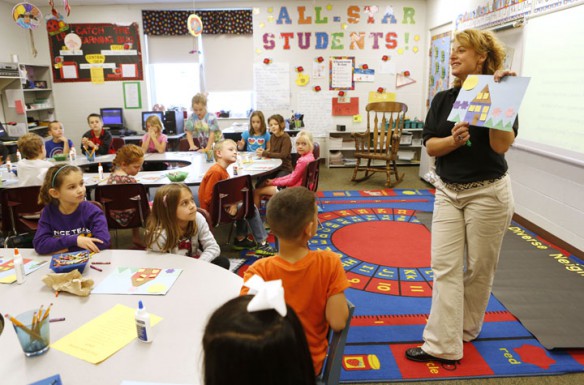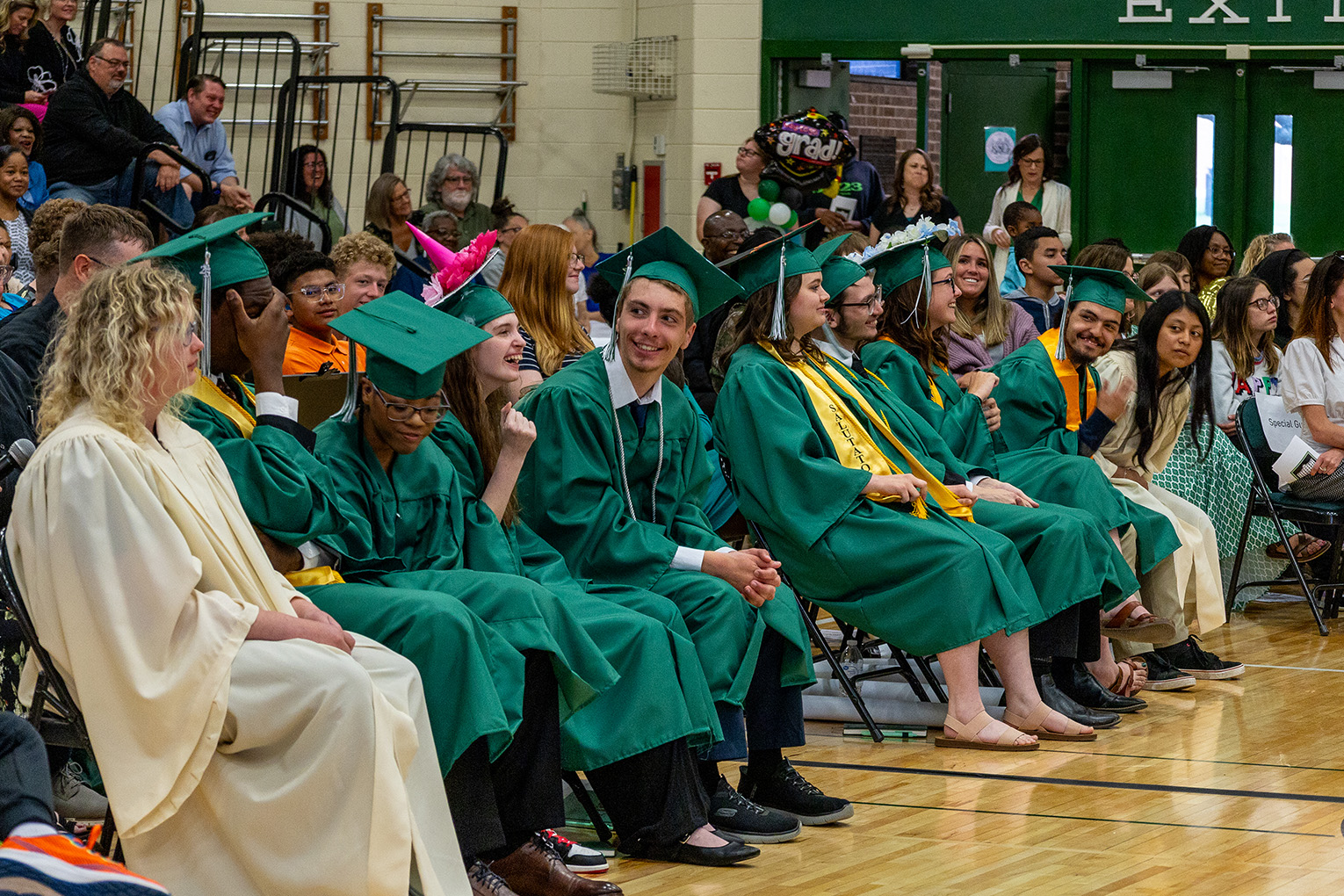
First-grade teacher Heidi Dees presents a student’s family glyph at Deer Park Elementary School (Daviess County). First-grade students at the school were studying families and diversity through the IB unit entitled “Who We Are.” Photo by Amy Wallot, Sept. 25, 2012
By Matthew Tungate
matthew.tungate@education.ky.gov
When Melanie Page applied to teach at Young Elementary School (Jefferson County), she wasn’t sure how the school could be using the International Baccalaureate (IB) program. The native Georgian had graduated from an IB high school – so the idea of teachers using inquiry-based instruction, speaking French and encouraging students to think globally at a school where 90 percent of the students are on free or reduced-price meals didn’t fit her concept of IB as a program for the affluent.
Now in her first year as a 4th-grade teacher at the school, Page realizes how wrong she was.
“There is no set IB student. These kids are very able and are doing excellent although this is a Title I school and they have other obstacles that they come in with, but you would not know,” she said.
Young Elementary and Deer Park Elementary School (Daviess County) are the only two Kentucky schools of about 335 in the country using the International Baccalaureate (IB) Primary Years Programme (PYP) for students 3 to 12 years old, according to the International Baccalaureate organization. The primary program focuses on inquiry-based learning and a global world view.
Teachers and administrators from both schools said IB units begin with backwards design, incorporating authentic assessment through both the formative assessment process and summative assessments; allow a lot of student choice, including allowing students to ask questions that can take lessons in surprising directions; and conclude with reflection of both students and teachers. Both schools also incorporate world language instruction.
Heidi Dees, a 1st-grade teacher at Deer Park Elementary, said she likes that IB is inquiry based, because teachers talk about what students already know and ask what they want to know when they start a new unit. The class researches the answers to students’ questions, which might include listening to a speaker from the community, conducting Internet research or getting books from the library to answer those questions.
“The kids are very involved in it because it’s their questions,” she said.
For instance, Mischelle Falloway, a 5th-grade teacher at Deer Park Elementary, had students generate questions based on IB concepts at the beginning of their Native American unit. That helped guide her instruction, she said.
“So that I am not strictly focusing on core content, but letting the students’ curiosity help guide instruction,” Falloway said.
Another IB staple is using “transdisciplinary” units that include multiple subjects to address six themes in a year:
- Who we are
- Where we are in place and time
- How we express ourselves
- How the world works
- How we organize ourselves
- Sharing the planet
Robin Nalley, staff developer and IB programme coordinator at Deer Park, said teachers meet schoolwide to plan vertically and horizontally in the summer and during the year to plan the 36 units a student will get from kindergarten to 5th grade.
“We want to make sure that we are packing in as much content, as much learning, as much skill-based action and experiences for the kids in those 36 units as possible,” she said.
Even though all six grades may use the same theme, it gets progressively harder each year, Nalley said. For instance, in the “Who we are” unit, it would progress like this:
K: myself
1st: families
2nd: communities
3rd: personal celebrations
4th: lifestyles
5th: rights and responsibilities
“IB requires quite a bit of planning,” she said.
Page said she and another 4th-grade teacher are going to take the concept of The Lion King and teach science, reading and social studies at Young Elementary.
“It gave us a cue or a way to bring together under our next unit, and I think it can’t get any more transdisciplinary than that,” Page said.
Aside from vertical and horizontal planning, Cabrina Bosco, PYP coordinator at Young Elementary, said teachers and staff their make their units available for other teachers to see. That allows the school’s five full-time itinerant teachers to be involved in collaborative planning as well.
Teachers and administrators at both schools also said IB encourages students to think globally about issues and to act to bring about change. Students at both schools have participated in numerous projects, such as raising money to provide safe drinking water in Uganda and for Habitat for Humanity, writing letters to injured soldiers and collecting money for a polar bear exhibit at the Louisville Zoo.
Young Elementary Principal Mary Minyard said many schools could do those things, but IB expects students to take what they have learned and act upon it. It’s difficult for teachers to plan lessons that make an impression on students, she said
“It’s much easier to do 25 spelling words and do a spelling test,” Minyard said.
IB puts many best practices into one program, which helps teachers focus and be intentional in their decisions, she said.
“We are asking our people to do something different and better than anybody else is,” Minyard said. “That’s a lot of dedication to something that they believe is valuable.”
When Deer Park Elementary began looking at using the IB program in 2008, Principal Cindy Galloway said administrators and teachers wanted to “raise the bar” for themselves.
“We have done more than that,” she said.” We have taken the whole lid off. Kids will soar just as high as their imaginations will let them go.”
Administrators at both schools said they had to follow a rigorous process to become an IB World School. That process includes an extensive application, reworking units to fit the IB model, receiving 100 percent agreement from teachers about participating and hosting a site visit from IB reviewers.
“By the time you get to that place where you’re authorized, you feel like you can talk about IB in your sleep,” Galloway said.
Deer Park began the IB process in 2008 and was authorized in February 2012.
Minyard said the superintendent in Jefferson County at the time suggested in 2008 that Young Elementary become an IB magnet. By December 2010, it was one, but not without countless hours of work by teachers and administrators.
That volume of work is one reason there are only two IB elementary schools in the state, administrators at both schools said.
Another is money. Minyard said IB schools have to pay a fee each year and be recertified every three years. This year, Young will spend about $10,000, including the recertification, she said.
The results are worth the trouble, though, Galloway said.
“It is quite a commitment on the part of a school and the part of a school district to move forward with a program like the IB PYP, but in the long run, when you really feel like it’s what’s best for kids, then there’s no way that you could stop,” she said.
MORE INFO …
IB Primary Years Programme
Robin Nalley, robin.nalley@daviess.kyschools.us, (270) 852-7270
Cabrina Bosco, cabrina.bosco@jefferson.kyschools.us, (502) 485-8354










[…] http://www.kentuckyteacher.org/features/2012/11/elementary-schools-use-ib-to-get-students-to-ask-que… […]